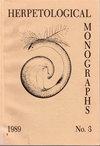THERMAL ECOLOGY OF DESERT TORTOISES IN THE EASTERN MOJAVE DESERT: SEASONAL PATTERNS OF OPERATIVE AND BODY TEMPERATURES, AND MICROHABITAT UTILIZATION
IF 1
2区 生物学
Q3 ZOOLOGY
引用次数: 127
Abstract
We monitored meteorological variables, daily and seasonal patterns of body tem- perature, corresponding operative temperatures, and microhabitat utilization by desert tortoises (Gopherus agassizii) during the 1991 and 1992 activity seasons of tortoises in the eastern Mojave desert. We studied tortoises in enclosures of natural habitat at the Desert Tortoise Conservation Center (DTCC) near Las Vegas, Nevada and a population of free-ranging tortoises in a field site adjacent to the DTCC. Air, ground and operative temperatures coincided with daily and monthly patterns of incident solar radiation. Variation in body temperature was primarily a consequence of microhabitat selection, principally use of burrows. During July-October, in the morning, body temperatures of tortoises in burrows were cooler than those of individuals on the surface. During midday, tortoises remained in burrows where body temperatures were cooler than extreme surface operative temperatures. While tortoises remained in burrows during much of the day, tortoises typically did not sleep in burrows at night. Microhabitat utilization was dictated by avoidance of extreme temperatures during midday, and microhabitat selection corresponded qualitatively to maintenance of energy and water balances. Effective conservation efforts to preserve habitat of desert tortoises will focus upon managing variables associated with integrity of burrows. ulation莫哈韦沙漠东部荒漠象龟的热生态:体温和体温的季节变化及微生境利用
在1991年和1992年莫哈韦沙漠东部荒漠象龟活动季节,对荒漠象龟(Gopherus agassizii)的气象变量、体温、活动温度的日、季节变化规律和微生境利用情况进行了监测。在内华达州拉斯维加斯附近的沙漠陆龟保护中心(DTCC),我们研究了自然栖息地圈养的陆龟和毗邻DTCC的野外散养陆龟种群。空气、地面和工作温度与入射太阳辐射的日和月模式一致。体温的变化主要是微生境选择的结果,主要是洞穴的使用。在7 - 10月的早晨,洞穴里的龟的体温比地面上的龟的体温低。在中午,陆龟呆在洞穴里,那里的体温比极端的地表工作温度要低。虽然陆龟白天大部分时间都呆在洞穴里,但陆龟晚上通常不在洞穴里睡觉。微生境的利用是由避免正午的极端温度决定的,而微生境的选择在质量上对应于维持能量和水的平衡。有效的保护沙漠象龟栖息地的工作将集中于管理与洞穴完整性相关的变量。较真
本文章由计算机程序翻译,如有差异,请以英文原文为准。
求助全文
约1分钟内获得全文
求助全文
来源期刊

Herpetological Monographs
生物-动物学
CiteScore
5.40
自引率
0.00%
发文量
2
审稿时长
>12 weeks
期刊介绍:
Since 1982, Herpetological Monographs has been dedicated to original research about the biology, diversity, systematics and evolution of amphibians and reptiles. Herpetological Monographs is published annually as a supplement to Herpetologica and contains long research papers, manuscripts and special symposia that synthesize the latest scientific discoveries.
 求助内容:
求助内容: 应助结果提醒方式:
应助结果提醒方式:


